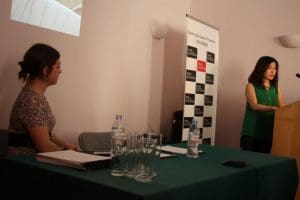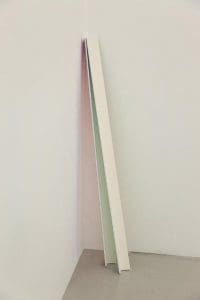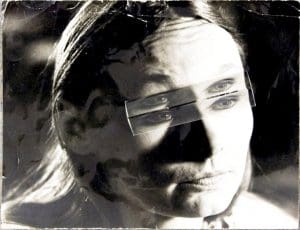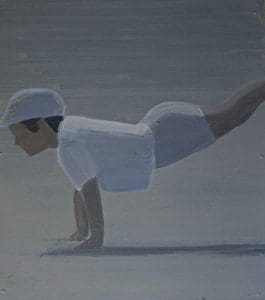
Becca Pelly-Fry watches presentation by Yukako Shibata.
West London’s Griffin Gallery gives free rein to six Japanese-born artists in new exhibition entitled Two Truths, By James Brewer
One of the most ambitious group exhibitions in London to feature Japanese-born contemporary artists has opened at the Griffin Gallery, an enterprising recent addition to the flourishing avant-garde territory in the capital.

From left: Miho Sato, Yukako Shibata, ICHASU, Kazuya Tsuji, Becca Pelly-Fry, Keisuke Katsuki, and Yuka Kurita
The show amounts to a rallying call to the wider arts community to focus greater attention on the adventurous work streaming from the studios of men and women who grew up in the world’s third biggest economy. Surprisingly, contemporary fine arts has largely been forced to take a back seat in Japan, in distinction to (perhaps even excessive) collector and investor enthusiasm for the genre in China, South Korea and some other Asian nations.

ICHASU at work. Courtesy Charlie Bennet.
The London show features three artists who have travelled from Japan, and three who are firmly established in London following their earlier studies.
Entitled Two Truths, the exhibition, which runs until July 11 2015, highlights individual and highly intelligent explorations of the iconographies and idiosyncracies of 21st century society. An eclectic array of exceptional photography, painting and sculpture speaks to themes that in a globalised era have become universal.
While the concept of two truths has a Buddhist origin, in this context there is a universal application and, as Griffin Gallery director Becca Pelly-Fry described it, a poetic nature in play. The exhibition touches on the motif of cultural displacement – such as Japanese-born artists working in the environment of an overseas country.
An aspect that emerges strongly in the show is how what might, some years back, have been considered alien influences infiltrate and bear down on Japanese custom and culture. Some of the artists address the mediation of imagery by the screens and filters of modern technology. A generation – not just visual artists, but musicians and writers – is foraging among “what is real out there and what is manipulated, ” as Ms Pelly-Fry put it.

Beyond II, 2015. By Yukako Shibata
She was speaking during an overview of the exhibition presented by all six artists at a special evening at the London headquarters of the Daiwa Anglo-Japanese Foundation. The symposium offered a fascinating but, commercially speaking, a downbeat insight into the state of contemporary art in Japan.
It is evident that what the contemporary movement, if such a collective description is apt, is producing is undervalued on its home ground both culturally and financially. Unlike the fevered investment scene in China, Hong Kong and South Korea, the market for new art in Japan is declining even from recent low levels. Lacking opportunity in Japan, young artists are migrating to London and New York, and lately to Berlin and various cultural hotspots in East Europe.
“Going abroad to study and trying to make a career outside Japan has become common, ” said Ms Pelly-Fry. In Japan, many artists have little choice but to earn a living as illustrators or graphic designers, while practising fine art “on the side, as it were, ” she said.

Monuments II, 2013. By Kazuya Tsuji.
Moderating the discussion at the Daiwa Foundation, Ms Pelly-Fry said that the exhibition posed the question of how the relationship of artistic practice to ‘truth’ might be affected by cultural displacement, given that most artists journey in search of personal truths.
She quizzed the artists about their relationship to Japan.
London-based Yukako Shibata, one of the artists, said she left Japan because it was too comfortable – “everybody was middle-class” – and she wanted to see the world, and to do something more difficult and challenging. “London has been my home for 20 years, ” she said approvingly.

School Ground 2014. By Miho Sato.
Another of the UK-resident artists, Kazuya Tsuji, said he left Japan because he wanted to study abroad, and “I think I like Japan more than when I was in Japan. It is nice to be abroad and find this side of me…”
Yukako, who was born in the Ishikari Bay city of Otaru, said that she trained as a painter, but making and creating objects had become a very important part of her practice. She referred to one of her largest pieces, an installation she had created for an exhibition at theAtrium Gallery of PricewaterhouseCoopers. She said she was intrigued by the changes that very subtle colour could make, and how using simple shapes, “negative space becomes positive, with colour.”

School Ground 2014. By Miho Sato.
She says of her delicate sculptures: “I explore the fugitive colours of the natural world and question the complex interplay of light, atmosphere and the human perceptual system. Finding the inner light in all things mundane inspires me, and it is these moments of reverie that are embodied in the work.”
Born in Fukuoka prefecture, Keisuke Katsuki takes as his starting point the image mediated through everyday high-tech screens. After all, the internet is where people who cannot go to museums to see a great work get their images, and much advertising comes by way of illuminated screens. Using computer techniques, he reduces in size the original image of modern and contemporary artworks, and then enlarges them so that the pixels are easily visible. Then he uses the red-green-blue pixel image to guide his painting in thick acrylics, producing a three-dimensional impact.

Untitled, 2014. By Yuka Kurita.
Kazuya Tsuji says teasingly that in some of his works, “basically I do not do anything.” One is a framed canvas with a piece of charcoal and “I ask someone to draw.” He is interested in the boundary between art and “just objects.” A simple juxtaposition can dramatically alter the viewer’s relationship to an image or object: “My work is very simple, it takes sometimes just one action to create.” For instance, he adds triangles to a block of marble, and he superimposes a prism on a black-and-white portrait photo to change the shape of the image. “When an image is shattered by a prism, it multiplies into a new form.” Another example was a photo from a fashion magazine, relit to create a startling new form.
Yuka Kurita, who lives in Sendai, re-slices everyday objects; in her current work the ‘muse’ is the packed salmon commonly sold by supermarkets in Japan. Re-shaped on canvas, the salmon slices breathe life back into the giant fish to bestow upon it a new identity which she calls sha-ke. Yuka says: “The salmon slices are the same per se but each slice is slightly different in its shape.” To her, as she works on her canvases, the changes she makes puts the notion of salmon to one side.

Yukako Shibata (left) and Miho Sato.
Miho Sato, who studied at City and Guilds and at the Royal Academy, recreates familiar cartoon images in trance-like compositions. For her, what she has seen in magazines and photos are images that lay dormant until they trigger a relationship to a childhood memory. Once when she was sleeping, “the Moomins appeared in my head” so she rushed to sketch the Tove Jansson characters in the way she had dreamed of them.
Her sources of inspiration are many and miscellaneous. Scenes from old films and from a children’s Ladybird book, at various times led her to create studies, some of which she describes as “attractive, but also odd.” One is based on a film scene of Catherine Deneuve cloaked for a funeral, others on Disney-like characters, but always with indistinct faces. One is even based on a wrist-band given to her at the gym. A reviewer has described Miho as “something of a militant magpie for the information age”

Kazuya Tsuji and Becca Pelly-Fry.
On a grand scale, Tokyo-born ICHASU tackles the cult of manga, the Japanese comic strips with usually adult themes, and out of this come her “slightly bizarre” depictions of people and animals. She takes a fresh look too at what goes on at events such as wedding, graduation, and other ceremonies.
Two of the exhibiting artists from Japan, ICHASU and Keisuke Katsuki, are in residence at Griffin Gallery until June 9. Situated under the headquarters of fine art materials brands Winsor & Newton, Liquitex and Conté à Paris, the gallery organises expert talks and advice sessions alongside its exhibition programme. The Studio Building has what it calls an Innovation and Development Laboratory, and two purpose-built artists’ studios.
Two Truths, a group exhibition of six Japanese artists, runs until July 11 2015 at Griffin Gallery, The Studio Building, 21 Evesham Street, London, W11.





